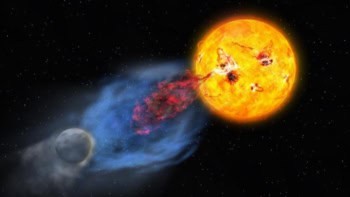His triumphs range from showing that our galaxy is speeding through the cosmos to producing the first models of star formation based on infrared light. Now, despite reaching retirement age, Imperial College London astrophysicist Michael Rowan-Robinson shows no sign of slowing his research, as he tells Jon Cartwright.

You graduated in maths from Cambridge University. What inspired you to go into astrophysics?
It was Fred Hoyle’s book Frontiers of Astronomy, which I bought while I was still an undergraduate. He presented this wonderful series of unsolved problems and speculated on a solution to each. It seemed a very lively field. So after graduating I did a one-year Masters course in maths and made sure I took all the astrophysics options.
Did the discovery of the cosmic microwave background in 1965 influence you too?
Absolutely. The year before, I had just started my PhD in cosmology with Bill McCrea, who was very interested in the steady-state theory – the idea that the universe is unchanging and that new matter is created continuously to compensate for the expansion of the universe. The discovery of the cosmic microwave background (CMB) was a bit of a blow to the steady-state idea because it seemed to be evidence of a hot Big Bang. But the results didn’t immediately rule out the steady-state theory. At first the measurements of the CMB were only at one or two wavelengths, so it wasn’t clear whether the results really showed true black-body radiation, which was integral to the Big Bang theory. So some of my early work investigated whether the steady-state theory really could be ruled out.
NASA’s WMAP satellite has allowed us study the CMB in great detail. What do you hope the Planck Surveyor will reveal about the CMB when it launches next year?
The Planck Surveyor will map the CMB to even higher resolution than the WMAP satellite, so its results should allow us to measure cosmological parameters like the density of the universe or the Hubble constant to an accuracy of 1%. At this level we should really feel confident that we know what kind of universe we live in. It is also possible that it could detect the imprint of primordial gravitational waves from the very early universe. We have no idea what the levels of these waves would be – they’d have to be pretty strong to be detected.
The bit I’m working on, however, is the all-sky survey of point sources at sub-millimetre wavelengths. This will help us to understand how galaxies formed in the first place, because we will be able to observe some of the most violent star-forming galaxies at very early times.
Some astronomers have claimed to see a pattern in the CMB that they call the “axis of evil”, suggesting the hot and cold patches in the CMB are not randomly distributed. Do you think data from the Planck Surveyor will rule out these claims?
It will certainly help clarify the situation. The “axis of evil” is an effect over the whole sky, so it might suggest large-scale anisotropies. This could mean that the universe is not infinite but cellular – a finite region that is endlessly repeated. But it is more likely that the pattern is a systematic error in our measurements.
While there may be primitive life on extrasolar planets, I do not think there is a profusion of extraterrestrial intelligence
What do you think is currently the biggest question in astrophysics?
Obviously there is a big issue with dark energy, but I’m not sure whether we’re going to succeed in solving that problem. I think it might just be something terribly basic that was laid down in the Big Bang that makes gravity pull locally and push on larger scales – basically Einstein’s theory of gravity with a cosmological constant.
In the next 10 to 20 years, however, the main thrust of astrophysics may shift away from cosmology towards planetary systems such as exoplanets.
Do you think that the search for exoplanets will reveal extraterrestrial life?
Personally I think that while there may be primitive life on extrasolar planets, I do not think there is a profusion of extraterrestrial intelligence. Given that there has been such an immense time period during which other civilizations could have existed, the fact that “they” don’t seem to be signalling to us and that they’re not visiting us suggests to me that for some reason they are not common.
There are two explanations for this. One is that it is very difficult to make that first step towards any kind of intelligent organism that would be capable of communicating with us. In the case of the Earth, we don’t know how we got from organic molecules to self-replicating plants and animals – it may have been the most amazing fluke that will never be repeated.
The other explanation is that as soon life gets intelligent enough it will soon destroy itself with nuclear weapons. But I don’t think that this idea works. Not all life would be as war-like as us – if the same experiment is repeated many times, it’s bound to last longer on some occasions than others.
You recently criticized NASA boss Michael Griffin for his dismissive comments on the need to tackle climate change. Do you think engaging climate change should be scientists’ number-one priority?
I do. Michael Griffin’s comments were unacceptable. He’s allowed to have his own reservations, but it was wrong of him to voice them to the media since he represents not only US space scientists but also those international partners like ourselves who collaborate with NASA. Space scientists have played an important part in identifying the problem and in convincing politicians that they need to act now.



